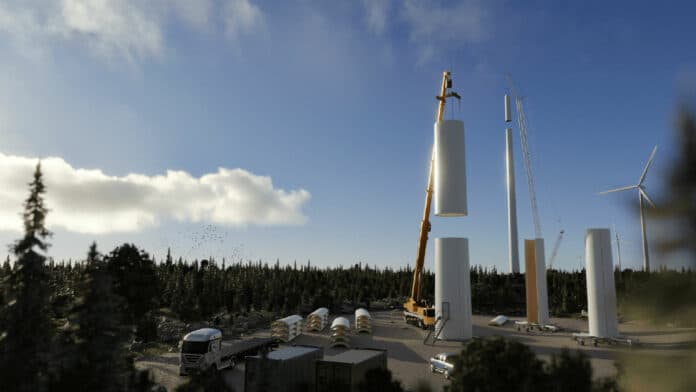Renewable energy does not emit greenhouse gases in the energy generation process making it one of the most viable and clean solutions to improve energy security. One of them is wind energy, which converts kinetic energy into electrical energy and is considered green. However, wind turbine towers are made of raw materials such as steel, concrete (for foundations) etc., which cause carbon emissions.
A wood technology company, Modvion, is building the world’s tallest wooden wind turbine tower for the energy company Varberg Energi, Skara in Sweden.
The wooden wind turbine tower project is part of Modvion’s Wind of Change project. It will be 105 meters tall, and the entire structure, including the turbine blades, will be 150 meters tall.
Modvion is installing a 2-megawatt Vestas V90 turbine on top of the tower, made by Vestas, a Danish wind turbine manufacturer.
The wooden modules used to make the tower are made from a type of wood called Laminated Veneer Lumber (LVL) manufactured in Modvion’s factory in Gothenburg. The company believes the laminated veneer wood used in the modules is stronger and more lightweight than traditional steel towers. The tower is covered with waterproof paint to ensure they are watertight.
The company uses Scandinavian spruce wood for its projects. Modvion wood used comes from sustainably managed northern forests certified for reforestation programs.
The patented modular design allows simple transportation on standard roads without requiring a lengthy permit process. This technology enables cost-effective and taller towers compared to traditional steel towers.
At the construction site, a tower for a wind turbine is made of modules assembled into several 16-24-meter-tall cylinders at the installation site, and the cylinders are then stacked on top of each other like a traditional tower.
According to the company, the lifespan of wooden wind turbine towers is approximately 25-30 years, and after the towers are dismantled, the material can be used in traditional buildings and many other applications. It also claims its wooden tower is carbon negative, meaning it stores more carbon dioxide than it emits during production, and this is because wood naturally absorbs carbon from the atmosphere.
Life cycle emissions from a 110 m high wind turbine tower in steel are approximately 1250 tonnes of carbon dioxide. Still, a corresponding tower in wood emits 90% less, i.e., around 125 tonnes of carbon dioxide.
“This is the start of a new green industry. By using Nordic raw materials and Swedish technology, we can enable climate-neutral wind power for a growing global market,” said Otto Lundman, CEO of Modvion, in the press release.
Work on the site began earlier this year with the foundation laying, and the wind turbine tower is set to be in operation before the end of 2023.
